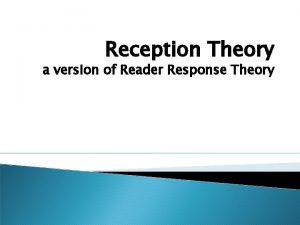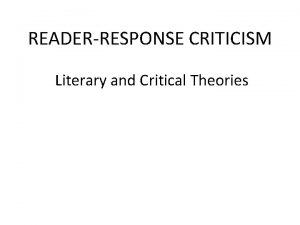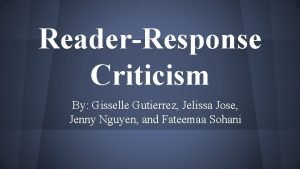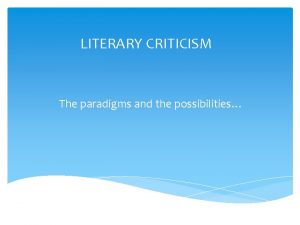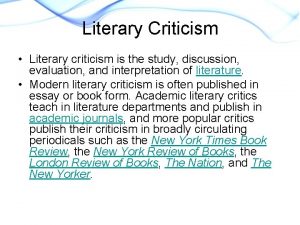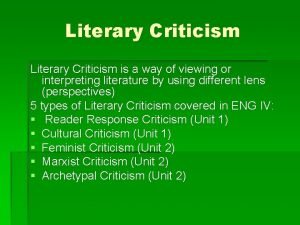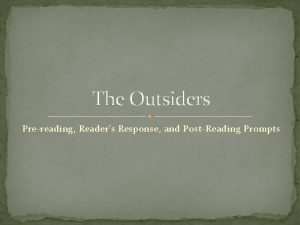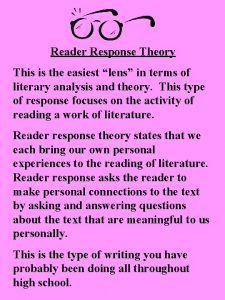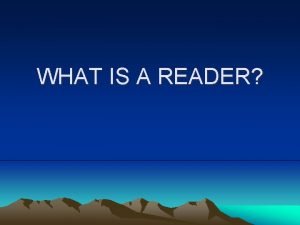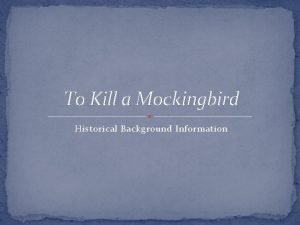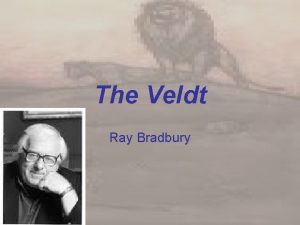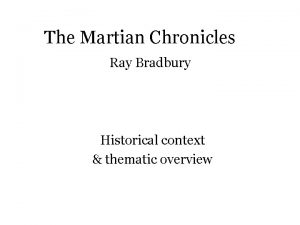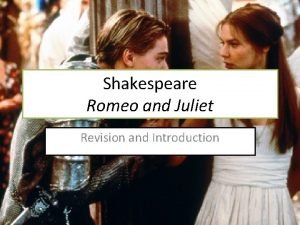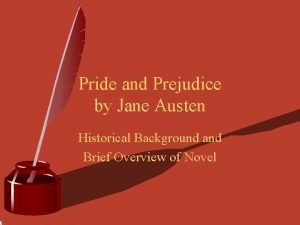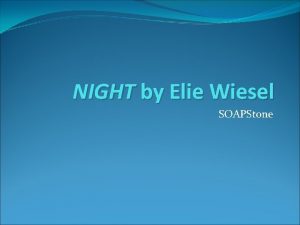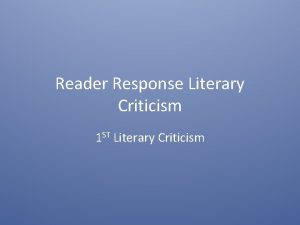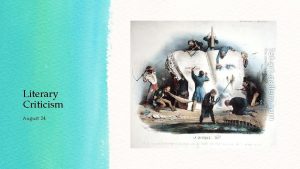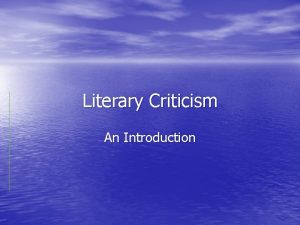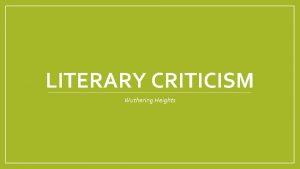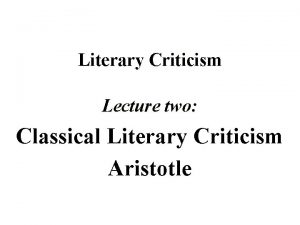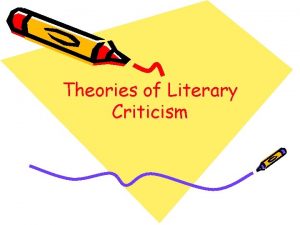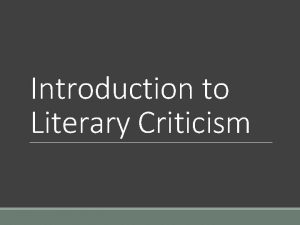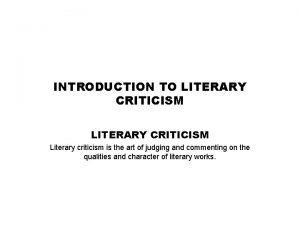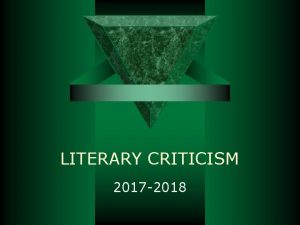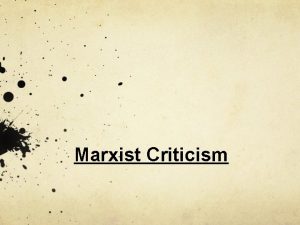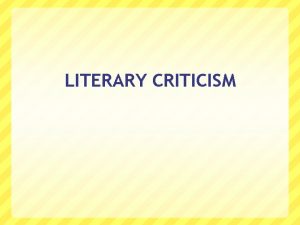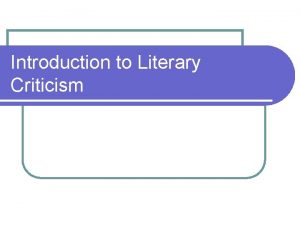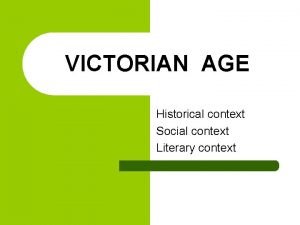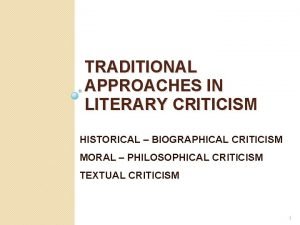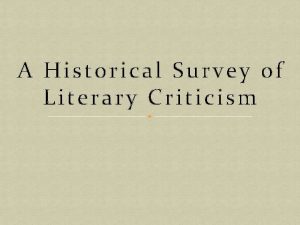Literary Criticism Reader Response Criticism Historical Context Louise

















- Slides: 17

Literary Criticism Reader Response Criticism

Historical Context Louise Rosenblatt's influential 1938 work Literature As Exploration n reaction to the formalist theories of the New Critics, who promoted "close readings" of literature n Initially->RR=bad because it relied too much on personal interpretation n

Definition n A form of criticism that stresses the importance of the reader's role in interpreting texts. Rejecting the idea that there is a single, fixed meaning inherent in every literary work, this theory holds that the individual creates his or her own meaning through a "transaction" with the text based on personal associations. Makes a text and opinion objective and unique

Key terms n n Horizons of expectations-reader’s ‘expectations’ of literature Implied reader-like target audience Interpretive communities-reader’s within a certain community share values, reading strategies etc Transactional analysis-how does reader interpret text and how text produces a response (think diction/imagery)

Objections (weaknesses) Too subjective n Fails to account for a text being able to expand a reader’s understanding n

To sum up “The Correct Reading” was traditionally the goal of literary criticism. n Reader response criticism is a reaction to this. How one interprets a text is subjective and is based on time, place, culture, etc. n

Literary Criticism Archetypal Criticism

Historical Context Based on works of Carl Jung and Joseph Campbell (and myth itself) n Popular in 1950 s and ‘ 60 s due to Canadian, Northrop Frye n

Definition Archetypal critics believe that literature is based on recurring images, characters, narrative designs and themes n Origins of western literature in Judeo. Christian scripture and Greco-Roman mythology n

What’s an Archetype Arche “first” and typos “form” n An original model or pattern from which copies are made n

Fundamental plot archetype n The Journey n n n protagonist moves from innocence to experience Begins in familiar environment Descent into danger Battle “monsters” in underworld (task) Return home (reunion, marriage)

Key Terms Anima n Animus n Collective Unconscious n Persona n Shadow n

Common Archetypal Figures n n n The Child The Hero The Great Mother The Wise old man The Trickster or Fox

Frye vs Jung n Frye sees archetypes as recurring patterns in literature; in contrast, Jung views archetypes as primal, ancient images/experience that we have inherited.

Objections Limits personal interpretation n Only analyses one aspect of literature (archetypes) n

In the fairy tale, Hansel and Gretel are loved by their father but resented by their step-mother, who insists on a journey into the woods with the intent of losing them. In the woods, the children meet evil in the guise of a witch who tries to kill them. But they outwit her, kill her, and return to their father. Their step-mother in some versions dies mysteriously at the same time as the witch. Familiar order is restored.

In groups of 3 -4, write a modern version of this fairy tale. Make sure your modern tale does not alter the original theme or message. Note how you used the archetypes within this tale. Be prepared to present to the rest of the class.
 What is transactional reader response theory
What is transactional reader response theory Reader response criticism
Reader response criticism Readers response criticism
Readers response criticism Literary approach
Literary approach Feminist literary approach
Feminist literary approach Reader response criticism cinderella
Reader response criticism cinderella Biblical criticism is not a form of historical criticism.
Biblical criticism is not a form of historical criticism. Outsiders writing prompts
Outsiders writing prompts Reader response
Reader response What is reader response
What is reader response Screen-reader-response
Screen-reader-response Significance criteria
Significance criteria Tkam historical context
Tkam historical context The veldt metaphors
The veldt metaphors Ray bradbury historical context
Ray bradbury historical context Historical context of romeo and juliet
Historical context of romeo and juliet Pride and prejudice background
Pride and prejudice background Historical context of night by elie wiesel
Historical context of night by elie wiesel
